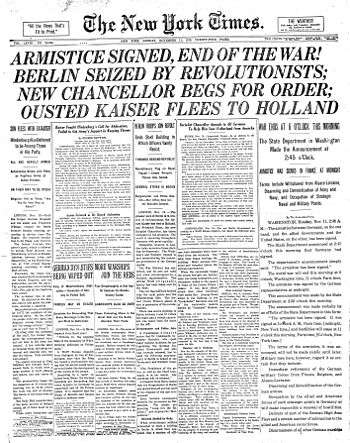Headline
The headline is the text indicating the nature of the article below it.
The large type front page headline did not come into use until the late 19th century when increased competition between newspapers led to the use of attention-getting headlines.
It is sometimes termed a news hed, a deliberate misspelling that dates from production flow during hot type days, to notify the composing room that a written note from an editor concerned a headline and should not be set in type.
Headlines in English often use a unique set of grammatical rules known as Headlinese.
Production of headlines

A headline's purpose is to quickly and briefly draw attention to the story. It is generally written by a copy editor, but may also be written by the writer, the page layout designer, or other editors. The most important story on the front page above the fold may have a larger headline if the story is unusually important. The New York Times's 21 July 1969 front page stated, for example, that "MEN WALK ON MOON", with the four words in gigantic size spread from the left to right edges of the page.[1]
The film The Shipping News has an illustrative exchange between the protagonist, who is learning how to write for a local newspaper, and his publisher:
- Publisher: It's finding the center of your story, the beating heart of it, that's what makes a reporter. You have to start by making up some headlines. You know: short, punchy, dramatic headlines. Now, have a look, [pointing at dark clouds gathering in the sky over the ocean] what do you see? Tell me the headline.
- Protagonist: HORIZON FILLS WITH DARK CLOUDS?
- Publisher: IMMINENT STORM THREATENS VILLAGE.
- Protagonist: But what if no storm comes?
- Publisher: VILLAGE SPARED FROM DEADLY STORM.
In the United States, headline contests are sponsored by the American Copy Editors Society, the National Federation of Press Women, and many state press associations.
Unusual headlines
A number of newspapers use humour, puns, alliteration or other word play devices in their headlines. Equally, the need to keep headlines brief occasionally leads to unintentional double meanings, if not double entendres. For example, if the story is about the president of Iraq trying to acquire weapons, the headline might be IRAQI HEAD SEEKS ARMS, or if some agricultural legislation is defeated in the United States House of Representatives, the title could read FARMER BILL DIES IN HOUSE.
- WALL ST. LAYS AN EGG – Variety on Black Monday (1929)
- STICKS NIX HICK PIX – Variety writing that rural moviegoers preferred urban films (1935)
- DEWEY DEFEATS TRUMAN – Chicago Tribune reporting the wrong election winner (1948)
- FORD TO CITY: DROP DEAD – New York Daily News reporting the denial of a federal bailout for bankrupt New York City (1975)
- MUSH FROM THE WIMP - Boston Globe in-house joke headline for an editorial, not changed before 161,000 copies printed. Theo Lippman Jr. of the Baltimore Sun declared "Mush from the Wimp" the second most famous newspaper headline of the 20th century, behind "Wall St. Lays an Egg" and ahead of "Ford to City: Drop Dead".[2]
- HEADLESS BODY IN TOPLESS BAR – New York Post on a local murder (1983)
- SAM SLEEPS! – New York Post over a front-page picture of mass-murderer David Berkowitz ("Son of Sam") asleep in his jail cell.[3]
- SICK TRANSIT'S GLORIOUS MONDAY – New York Daily News reporting a state transit bailout (1980)[4]
- GOTCHA! – The UK Sun on the torpedoing of the Argentine ship Belgrano and sinking of a gunboat during the Falklands War (1982)
- FREDDIE STARR ATE MY HAMSTER – The UK Sun (1986), claiming that the comedian had eaten a fan's pet hamster in a sandwich. The story was later proven false, but is seen as one of the classic tabloid newspaper headlines.[5]
- GREAT SATAN SITS DOWN WITH THE AXIS OF EVIL – The Times (UK) on US-Iran talks (2007)[6]
- SUPER CALEY GO BALLISTIC CELTIC ARE ATROCIOUS – Sun on Inverness Caledonian Thistle beating Celtic in the Scottish Cup[7]
Editor of The New Republic, Michael Kinsley, began a contest to find the most boring newspaper headline.[8] According to him, no entry surpassed the one that had inspired him to create the contest: "WORTHWHILE CANADIAN INITIATIVE",[9] over a column by The New York Times' Flora Lewis.[10]
See also
- A-1 Headline, a 2004 Hong Kong film
- Bus plunge, a type of news story, and accompanying headline
- Headlines (from The Tonight Show with Jay Leno)
- lead paragraph
- Syntactic ambiguity, leads to multiple humorous possible alternative interpretations of written headline
Further reading
- Harold Evans News Headlines (Editing and Design : Book Three) Butterworth-Heinemann Ltd (February 1974) ISBN 0-434-90552-6 ISBN 978-0-434-90552-2
- Fritz Spiegl What The Papers Didn't Mean to Say Scouse Press, Liverpool, 1965
References
- ↑ Wilford, John Noble (14 July 2009). "On Hand for Space History, as Superpowers Spar". The New York Times. Retrieved 24 April 2011.
- ↑ Scharfenberg, Kirk (1982-11-06). "Now It Can Be Told . . . The Story Behind Campaign '82's Favorite Insult". Boston Globe (Boston, Massachusetts). p. 1. Retrieved 2011-01-20. Abstract only; no article without payment.
- ↑ Google Books search result
- ↑ The New York City Transit Authority in the 1980s
- ↑ "Telegraph wins newspaper vote". BBC News. 25 May 2006.
- ↑ Great Satan sits down with the Axis of Evil
- ↑ "Super Caley dream realistic?". BBC. 22 March 2003.
- ↑ Kinsley, Michael (1986-06-02). "Don't Stop The Press". The New Republic. Retrieved April 26, 2011.
- ↑ Lewis, Flora (4 October 1986). "Worthwhile Canadian Initiative". New York Times. Retrieved 9 March 2013.
- ↑ Kinsley, Michael (28 July 2010). "Boring Article Contest". The Atlantic. Retrieved 26 April 2011.
External links
| Look up headline in Wiktionary, the free dictionary. |
- Front Page - The British Library Exhibition of famous newspaper headlines